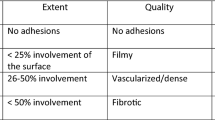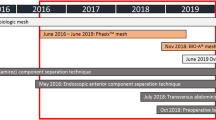Abstract
Aim
To present our single institution and surgeon’s complex abdominal wall reconstructions (CAWR) experience with Permacol™ mesh through a non-randomized study.
Patients and method
Data of 51 consecutive patients were prospectively collected between 2003 and 2015. Patients had a median of 3 comorbidities (range 0–10) and 68% were Center for Disease Control class II–IV. The mean previous repair was 1.3 (range, 0–12), and 25 (44%) had a mesh in situ. The median defect size was 625 cm2.
Results
Among the 56 CAWR procedures, in 16 (29%) bowel resection/anastomosis was performed. The overall post-operative complication rate was 45%, and it was wound-related except from 1 patient dead for myocardial infarction. One was lost at follow-up. Five were re-operated for recurrence with a second Permacol mesh, leading to 14 (26%) overall recurrences at a mean follow-up of 44 months (range, 4–123). In 33 (59%) cases, fascial closure was achieved. The mesh placement was intraperitoneal in 89%, retro-muscular in 9% and supra-fascial in 1% of cases. A multivariate analysis showed that predictor risk for recurrence was more than 3 previous repairs, wound class III–IV, whereas age, type of comorbidities, defect size and fascial closure did not influence the recurrence. Median post-operative performance status was 0 (range; 0–3). A satisfaction questionnaire was obtained in 43 patients, and 86% of them were satisfied with the outcome.
Conclusions
Biological materials have the potential to reduce morbidity and improve outcome of definitive repair of CAWR.

Similar content being viewed by others
References
Breuing K, Butler CE, Ferzoco S et al (2010) Incisional ventral hernias: review of the literature and recommendations regarding the grading and technique of repair. Surgery 148(3):544–558. doi:10.1016/j.surg.2010.01.008
Slater NJ, Montgomery A, Berrevoet F et al (2014) Criteria for definition of a complex abdominal wall hernia. Hernia 18(1):7–17. doi:10.1007/s10029-013-1168-6
Burger JWA, Luijendijk RW, Hop WCJ, Halm JA, Verdaasdonk EGG, Jeekel J (2004) Long-term follow-up of a randomized controlled trial of suture versus mesh repair of incisional hernia. Ann Surg 240(4):578–583. doi:10.1097/01.sla.0000141193.08524.e7 discussion 583–585
Luijendijk RW, Hop WC, van den Tol MP et al (2000) A comparison of suture repair with mesh repair for incisional hernia. N Engl J Med 343(6):392–398. doi:10.1056/NEJM200008103430603
Mathes SJ, Steinwald PM, Foster RD, Hoffman WY, Anthony JP (2000) Complex abdominal wall reconstruction: a comparison of flap and mesh closure. Ann Surg 232(4):586–596. doi:10.1097/00000658-200010000-00014
Sauerland S, Schmedt CG, Lein S, Leibl BJ, Bittner R (2005) Primary incisional hernia repair with or without polypropylene mesh: a report on 384 patients with 5-year follow-up. Langenbeck’s Arch Surg 390(5):408–412. doi:10.1007/s00423-005-0567-2
Rodriguez ED, Bluebond-Langner R, Silverman RP et al (2007) Abdominal wall reconstruction following severe loss of domain: the R Adams Cowley Shock Trauma Center algorithm. Plast Reconstr Surg 120(3):669–680. doi:10.1097/01.prs.0000270303.44219.76
Slater NJJ, van der Kolk M, Hendriks T, van Goor H, Bleichrodt RPP (2013) Biologic grafts for ventral hernia repair: a systematic review. Am J Surg 205(2):220–230. doi:10.1016/j.amjsurg.2012.05.028
Sarmah BD, Holl-Allen RTJ (1984) Porcine dermal collagen repair of incisional herniae. Br J Surg 71(7):524–525. doi:10.1002/bjs.1800710717
Ramirez OM, Ruas E, Dellon AL (1990) “Components separation” method for closure of abdominal-wall defects: an anatomic and clinical study. Plast Reconstr Surg 86(3):519–26. Available at: http://www.ncbi.nlm.nih.gov/pubmed/2143588. Accessed 10 Nov 2015
Carbonell AM, Cobb WS, Chen SM (2008) Posterior components separation during retromuscular hernia repair. Hernia 12(4):359–362. doi:10.1007/s10029-008-0356-2
Wang F, Buonocore S, Narayan D (2011) Tunnelled tensor fascia lata flap for complex abdominal wall reconstruction. BMJ Case Rep. doi:10.1136/bcr.08.2010.3236
Bikhchandani J, Fitzgibbons RJ (2013) Repair of giant ventral hernias. Adv Surg 47:1–27. doi:10.1016/j.yasu.2013.02.008
Tukiainen E, Leppäniemi A (2011) Reconstruction of extensive abdominal wall defects with microvascular tensor fasciae latae flap. Br J Surg 98(6):880–884. doi:10.1002/bjs.7489
de Vries Reilingh TS, van Goor H, Charbon JA et al (2007) Repair of giant midline abdominal wall hernias: “components separation technique” versus prosthetic repair: interim analysis of a randomized controlled trial. World J Surg 31(4):756–763. doi:10.1007/s00268-006-0502-x
Butler CE, Prieto VG (2004) Reduction of adhesions with composite AlloDerm/polypropylene mesh implants for abdominal wall reconstruction. Plast Reconstr Surg 114(2):464–473. doi:10.1097/01.PRS.0000132670.81794.7E
Halm JA, De Wall LL, Steyerberg EW, Jeekel J, Lange JF (2007) Intraperitoneal polypropylene mesh hernia repair complicates subsequent abdominal surgery. World J Surg 31(2):423–429. doi:10.1007/s00268-006-0317-9
Bingener J, Kazantsev GB, Chopra S, Schwesinger WH (2016) Adhesion formation after laparoscopic ventral incisional hernia repair with polypropylene mesh: a study using abdominal ultrasound. JSLS 8(2):127–31. Available at: http://www.pubmedcentral.nih.gov/articlerender.fcgi?artid=3015540&tool=pmcentrez&rendertype=abstract. Accessed 10 Feb 2016
Sandvall BK, Suver DW, Said HK et al (2014) Comparison of synthetic and biologic mesh in ventral hernia repair using components separation technique. Ann Plast Surg. doi:10.1097/SAP.0000000000000253
Mulier KE, Nguyen AH, Delaney JP, Marquez S (2011) Comparison of Permacol™ and Strattice™ for the repair of abdominal wall defects. Hernia 15(3):315–319. doi:10.1007/s10029-010-0777-6
Helton WS, Fisichella PM, Berger R, Horgan S, Espat NJ, Abcarian H (2005) Short-term outcomes with small intestinal submucosa for ventral abdominal hernia. Arch Surg 140(6):549–560. doi:10.1001/archsurg.140.6.549 discussion 560–562
Ueno T, Pickett LC, De La Fuente SG, Lawson DC, Pappas TN (2004) Clinical application of porcine small intestinal submucosa in the management of infected or potentially contaminated abdominal defects. J Gastrointest Surg 8(1):109–112. doi:10.1016/j.gassur.2003.09.025
Gaertner WB, Bonsack ME, Delaney JP (2007) Experimental evaluation of four biologic prostheses for ventral hernia repair. J Gastrointest Surg 11(10):1275–1285. doi:10.1007/s11605-007-0242-8
Iacco A, Adeyemo A, Riggs T, Janczyk R (2014) Single institutional experience using biological mesh for abdominal wall reconstruction. Am J Surg 208(3):480–484. doi:10.1016/j.amjsurg.2013.09.020 discussion 483–4
Cheng AW, Abbas MA, Tejirian T (2013) Outcome of abdominal wall hernia repair with permacolTM biologic mesh. Am Surg 79:992–996
Giordano P, Pullan RD, Ystgaard B et al (2015) The use of an acellular porcine dermal collagen implant in the repair of complex abdominal wall defects: a European multicentre retrospective study. Tech Coloproctol 19(7):411–417. doi:10.1007/s10151-015-1307-4
Abdelfatah MM, Rostambeigi N, Podgaetz E, Sarr MG (2015) Long-term outcomes (>5-year follow-up) with porcine acellular dermal matrix (Permacol) in incisional hernias at risk for infection. Hernia 19(1):135–140. doi:10.1007/s10029-013-1165-9
Flum DR, Horvath K, Koepsell T (2003) Have outcomes of incisional hernia repair improved with time? A population-based analysis. Ann Surg 237(1):129–135. doi:10.1097/00000658-200301000-00018
Bauer JJ, Harris MT, Gorfine SR, Kreel I (2002) Rives-Stoppa procedure for repair of large incisional hernias: experience with 57 patients. Hernia 6(3):120–123. doi:10.1007/s10029-002-0071-3
Rosen MJ (2016) Atlas of abdominal wall reconstruction rosen. Elsevier. Available at: https://elsevier.ca/product.jsp?isbn=9781437727517. Accessed 15 Feb 2016
Jin J, Rosen MJ, Blatnik J et al (2007) Use of acellular dermal matrix for complicated ventral hernia repair: does technique affect outcomes? J Am Coll Surg 205(5):654–660. doi:10.1016/j.jamcollsurg.2007.06.012
Patel KM, Nahabedian MY, Albino F, Bhanot P (2013) The use of porcine acellular dermal matrix in a bridge technique for complex abdominal wall reconstruction: an outcome analysis. Am J Surg 205(2):209–212. doi:10.1016/j.amjsurg.2012.05.031
Boehmler JH, Butler CE, Ensor J, Kronowitz SJ (2009) Outcomes of various techniques of abdominal fascia closure after TRAM flap breast reconstruction. Plast Reconstr Surg 123(3):773–781. doi:10.1097/PRS.0b013e318199ef4f
Acknowledgements
Ms. Valentina Pannetta for the statistical support.
Author information
Authors and Affiliations
Corresponding author
Rights and permissions
About this article
Cite this article
Limura, E., Giordano, P. Biological Implant for Complex Abdominal Wall Reconstruction: A Single Institution Experience and Review of Literature. World J Surg 41, 2492–2501 (2017). https://doi.org/10.1007/s00268-017-4066-8
Published:
Issue Date:
DOI: https://doi.org/10.1007/s00268-017-4066-8




